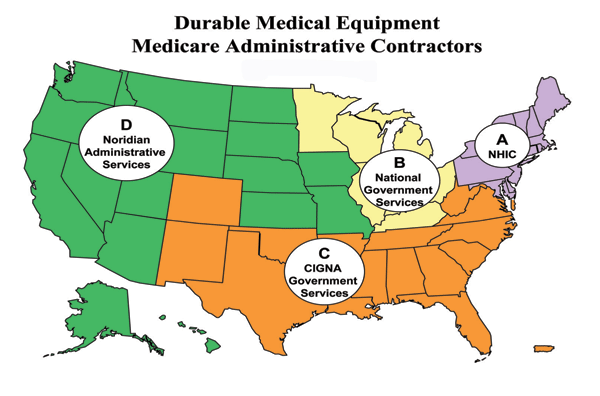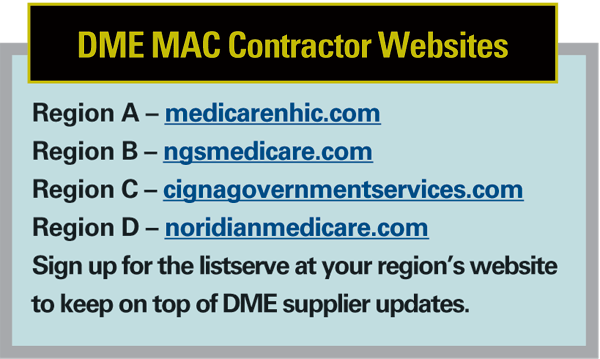While initial directives from the Centers for Medicare & Medicaid Services seemed to indicate that physicians who provided eyeglasses and contact lenses to their postop cataract patients were exempt from the requirements of a surety bond, the issue took a new turn last fall.
At that time, the National Supplier Clearinghouse issued a guidance that interpreted the statutory language from the Federal Register (January 2, 2009). It stated, "All existing DMEPOS [Durable Medical Equipment, Prosthetics, Orthotics and Supplies] suppliers subject to the bonding requirements shall submit a copy of the required surety bond to the NSC no later than October 2, 2009." The NSC guidance contradicts CMS's indications that persons receiving post-cataract eyewear are considered the ophthalmologist's patients, whether or not they had cataract surgery performed by that practice.

Under this new interpretation, surety bonds are required as follows:
• if the optical shop is a separate corporation and has a separate tax ID from the doctor, the doctor's practice or the group practice. This applies even if the optical is a second corporation that is physician-owned.
• if a patient comes in with a prescription after cataract surgery from an outside source, such as a referring physician. Unless this patient is your patient, i.e., has an exam or test done by your doctors, your optical has to be covered by a surety bond in order for you to fill the outside Rx utilizing the patient's Medicare benefits.
• if you are enrolling as a Medicare DME supplier for the first time, an existing supplier undergoing a change of ownership, an existing supplier establishing a new practice location or reactivating/reenrolling a location, you are required to submit a surety bond.
It is important to note that these guidelines apply whether or not you are a participating provider. All DME suppliers must conform to the Medicare DMEPOS Supplier Stand-ards in order to retain their billing privileges. You can download both the long and short versions of the 26 supplier standards at palmettogba.com.
If CMS Contacts You
Starting November 9, 2009, CMS began contacting DME suppliers who had not submitted proof of a surety bond to NSC. Letters were sent to physicians, optometrists and opticians who appeared to be non-compliant because they did not submit proof of their surety bond and did not appear to meet the exemptions.
The letter stated that the recipient's Medicare supplier number would be revoked effective 30 days from the postmark of the letter and that the supplier would be barred from re-enrolling in the Medicare program for one year from the effective date of revocation.

If you receive a letter from CMS, the first thing to do is make sure that your optical does indeed require a surety bond. If you fall under the previously listed requirements, then you most likely need a surety bond. Remember, you will need a surety bond for each optical location if that location is a DME supplier (with a National Provider Identifier number and a DME Provider Transaction Access Number). Many practices make the mistake of dispensing postop eyewear to their patients at another one of their optical locations that does not have an NPI or PTAN. The practice may think the billing can be generated from another one of its locations that has the PTAN and NPI. This is incorrect and will cause claim rejection.
If you have already acquired a surety bond before the October 2, 2009 deadline, then you should immediately e-mail NSC: nsc.revocations@palmettogba.com. You must send them proof that you acquired a surety bond before the Oct 2, 2009 deadline.
If you acquired the surety bond after the deadline, you must go through the procedure of submitting a CAP (Corrective Action Plan), along with proof of your surety bond within 30 days of the postmark of the CMS letter.
Bond Requirements, PTAN and NPI
If you have not acquired a surety bond and need to do so, here is the process to get started.
You should contact one of the sureties identified on the U.S. Department of Treasury's listing: www.fms.treas.gov/c570/c570_a-z.html. These sureties are considered "authorized" sureties and are therefore the only sureties from which a bond may be obtained. I have worked with LSJ Insurance (lsjins.com) to secure surety bonds.
All surety bond insurance companies will require you to have a valid NPI number and DME supplier PTAN. Be sure that these numbers are current.
You must have a separate organizational NPI for your optical. Check the Registry (nppes.com) to see that the proper taxonomy code is used for "Eyewear Supplier" and that your PTAN number is entered in "Other Provider Information."
Regarding your DME Supplier number (PTAN), check to see if it is current by contacting NSC. You will need your login and password information to access your DME Supplier account. Also, go on-line to see if you are properly registered in the DME Supplier Directory (medicare.gov).
Surety Bond Application Tips
Surety bond company owner, Samir Jallad of LSJ Insurance, indicates that these are the most common mistakes made on surety bond applications:
• The name of the optical business applying does not match with NPI or PTAN records.
• Invalid or missing PTAN or NPI numbers
• The applicant does not match DME authorized official of record.
• The address/phone do not match NPI or PTAN records.
• General application information is not completed.
Once the surety bond application is completed, processing is usually very quick. Upon receipt of the surety bond, it is important that the rest of the application process be completed as quickly as possible in order to meet CMS's 30-day response requirement.
The surety bond information must be accompanied by a CAP (corrective action plan).
This is a letter, on the applicant's optical letterhead, signed by the authorized official. It should indicate that this is a corrective action plan and state that the applicant meets all of the requirements of the DME Supplier Standards, which now include the surety bond requirement. A copy of the surety bond documentation must be included. Mail this paperwork to: National Suppliers Clearinghouse,
The National Supplier Clearinghouse warns that it may take two weeks for your submission documentation to show up in the NSC. That's why expediting your paperwork as soon as you are contacted by CMS is so critical. It is hoped that your postmarked CAP received by NSC within 30 days of their original letter will qualify to meet their deadline requirements, regardless of how long the paperwork processing takes at NSC.
If you do not meet the 30-day requirement, you still have a 60-day window to appeal the revocation decision. In this case, you must submit both a CAP and reconsideration. The reconsideration process will, however, require your presentation of your case before an independent hearing officer from CMS.
If you do not follow up on the revocation letter with a CAP or reconsideration, or if you do not receive a favorable decision on your appeal, you must wait one full year before resubmitting a CMS 855s application to be considered for re-enrollment as a DME supplier.
Ms. Fritz operates Ophthalmology Resources, which specializes in Medicare postop eyewear claims and reimbursement (ophthalmologyresources.com). Contact her at pfmdresources@sbcglobal.net or (860) 669-9057.





